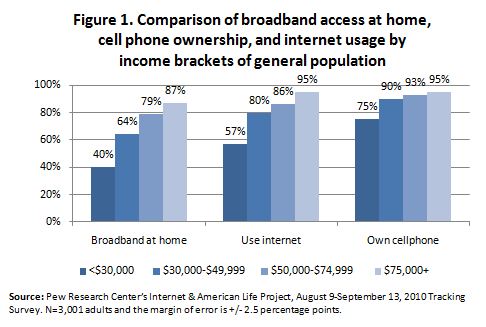Webopedia defines the Digital Divide as “A term used to describe the discrepancy between  people who have access to and the resources to use new information and communication tools, such as the Internet, and people who do not have the resources and access to the technology. The term also describes the discrepancy between those who have the skills, knowledge and abilities to use the technologies and those who do not. The digital divide can exist between those living in rural areas and those living in urban areas, between the educated and uneducated, between economic classes, and on a global scale between more and less industrially developed nations“.
people who have access to and the resources to use new information and communication tools, such as the Internet, and people who do not have the resources and access to the technology. The term also describes the discrepancy between those who have the skills, knowledge and abilities to use the technologies and those who do not. The digital divide can exist between those living in rural areas and those living in urban areas, between the educated and uneducated, between economic classes, and on a global scale between more and less industrially developed nations“.
The so-called “digital divide” is a complex multifaceted issue, which includes social, economical, physical, geographical and educational barriers to the deployment and scaling of innovative transportation solutions. Although not new to the transportation industry, the digital divide is gaining in importance, as innovation is increasingly reliant on digital technologies. So the primary question at this point: Is the divide closing or widening in the era of next generation transportation solutions? And what can be done to facilitate improved accessibility for all demographics across all platforms.
Technological Barriers
The recent megatrend of “consumerization” is shifting ownership of critical components of transportation systems from the traditional public control to the private end-user (traveler). This paradigm shift is a relatively new phenomena in the ITS industry, and one that now places a significant reliance on the use of privately-owned technologies. Although the affects of this new technology delivery model are not fully understood at this point, it is clear that market penetration will be a key factor to their overall success.
Consider that it took approximately 15 years for the cell phone to achieve 92% market penetration among all people in the United States, and that the smartphone is tracking to reach that level of penetration in one-half to one-third the time. However, transportation solutions will need to contend with a technology and service divide for the near term.
Vehicle-based technologies have also created a divide, as newer platforms have facilitated improved safety and efficiency. However, the full value of these technologies cannot be fully realized by all automobile owners for the better part of the next decade, if not longer.
Other technological barriers are outside of the end-users control. For example, geographic barriers, such as those associated with wireless communications availability, demonstrate the divide based on accessibility outside the reach of an end-user.
Economic Barriers
In many cases, economic barriers to next-gen ITS go hand-in-hand with the aforementioned technological barriers. However, in many cases the divide is solely based on the ability of the end-user to afford the purchase and on-going costs to operate technologies necessary to participate and support certain next-generation ITS solutions. The credit barrier is another barrier that is not unique to the ITS industry, but one that must be continuously dealt with as the digital age evolves, and the mainstreaming of next-gen ITS continues.
Social Barriers
Education is a multifaceted barrier in its own right. Simply making technology accessible to  all consumers is not enough to ensure successful use. End-users must not only know how to operate technologies, but must be informed and understand how to realize the potential values of the devices. Language barrier, whether to discern DMS messages, utilize mobile applications, or simply understand static street signs has been mostly unaddressed. The Digital Divide also includes accessibility as it relates to age and disabilities, and subsequent inabilities to access Information and Communications Technologies, or ICT.
all consumers is not enough to ensure successful use. End-users must not only know how to operate technologies, but must be informed and understand how to realize the potential values of the devices. Language barrier, whether to discern DMS messages, utilize mobile applications, or simply understand static street signs has been mostly unaddressed. The Digital Divide also includes accessibility as it relates to age and disabilities, and subsequent inabilities to access Information and Communications Technologies, or ICT.
Conclusion
Recent trend analysis and conservative projections are showing a narrowing of the digital divide with regards to many of the demographic components of the digital divide. However, in some ways, transportation industry professionals will always have to contend with some form of the digital divide.
The digital divide is taking on new characteristics, now becoming a two way street. What was once a void of opportunity on the users end, is now limiting potential for systems to capitalize on potential user data. We, as ITS practitioners, planners and designers should be continuously cognizant of the digital divide, the barriers presented, and strive for development and deployment of next-generation ITS solutions with the aforementioned barriers in mind. It is my position, that ITS should always consider non-technological solutions and methodologies as an integral component of all ITS deployments, and continuously focus on narrowing the digital divide as much as possible.
References and Resources
Pew Internet & American Life Project
Smartphone penetration skyrockets in 2011, iPhone becomes No.1 handset
Digital Divide: From Computer Access to Online Activities – A Micro Data Analysis
Digital Divide: If You’re Reading This, You’re One of the Lucky Ones [INFOGRAPHIC]



